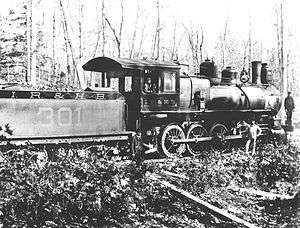Iron Range and Huron Bay Railroad
The Iron Range & Huron Bay Railroad (IR&HB) is a defunct railroad constructed to haul iron ore in Michigan's Upper Peninsula during the 1890s. Financial and engineering problems prevented the railroad's operation; it remains an unusual example of a railroad which was completed but never used.

Background
Rich iron ore deposits were first discovered in the Upper Peninsula in the 1840s, and remain a significant source of wealth for the state. By the 1890s Michigan was the largest supplier of iron ore in the United States. Railroads would haul ore from the mines to great ore docks on the Great Lakes in places such as Escanaba and Marquette, where it would be loaded on ore freighters and transported to the rest of the country. The Huron Mountains west of Marquette were known to be rich in ore deposits, particularly around Lake Michigamme (near Michigamme, Michigan), and were believed to contain marble, granite, silver, gold, lead, graphite, asbestos, and silica.[1]
History
The IR&HB was formed on June 27, 1890 by seven businessmen, all from Michigan's Lower Peninsula and all but one from Detroit. Milo H. Davis, also of Detroit, was engaged as chief engineer. The company proposed to construct a line from Champion, near the Lake Michigamme ore fields, to a new ore dock on Huron Bay (in Arvon Township), which connected to Lake Superior. From there the ore would be shipped by freighter through the Soo Locks.[2]
Construction
The terrain for the line proved forbidding. The country was hilly and broken; grading the roadbed proved an expensive and intensive activity. By June 1891 an initial workforce of 500 men had swelled to 1,500, which strained the local transportation network. The builder, Wallace Dingman of Battle Creek, Michigan, ran out of money in August and abandoned work, leaving the IR&HB with unpaid bills and swamping Marquette County's limited poor relief resources. New contractors were hired and the grading was finally finished in the summer of 1892, reportedly at the cost of $400,000–well above the $265,000 budgeted for the project. One major obstacle was a 1,000-foot (305 m) cut near Mount Arvon, from which 40,000 cubic yards (31,000 m3) of rock were removed. The rails were laid between July and November 1892.[3]
The ore dock was built on the shores of Huron Bay for $170,000 under the supervision of John Munro, Jr. It measured 1,000 feet (305 m) in length and required 2,000,000 board feet (4,719 m3) of lumber. A sawmill was constructed to process the vast amounts of timber necessary for the project.[4]
Failure
Although the IR&HB completed the 42-mile (68 km) line[5] between Champion and Huron Bay and purchased two 4-8-0 "Mastodon" steam locomotives from the Brooks Locomotive Works, no trains were ever operated. The completion of the line coincided with the Panic of 1893, which reduced the demand for iron ore. Additionally, the ore mines around Lake Michigamme–which the IR&HB had intended to serve–began to play out. There were richer mines in Ishpeming to the east, but the IR&HB lacked the wherewithal to construct such a line, which would have spanned 15 to 20 miles (24 to 32 km). In places the IR&HB line exceeded a grade of 5%, which would have made the haulage of freight difficult.[6]
By 1893 the IR&HB found itself in serious financial difficulties. In 1890 it had begun with $1,400,000 in capital through an initial stock issue coupled with the sale of bonds. Additional bonds worth $600,000 were sold to cover construction overruns and keep the railroad afloat, but its debts mounted. Finally, in 1900, the company's owners sold it outright to the Detroit Construction Company for $110,000.[7]
Legacy
Following the sale the Detroit Construction Company dismantled the entire line. The rails were re-used in various interurban schemes in the Lower Peninsula, including the Grand Rapids, Holland and Lake Michigan Rapid Railway and the Detroit, Lake Orion and Flint Railway. The two locomotives were sold to the Algoma Central Railway. The great ore dock was dismantled and shipped to Detroit.[8]
Davis, the chief engineer, fled to Mexico to escape allegations of fraud.[9] According to the New York Times, the state took possession of the right-of-way and other property as compensation for unpaid taxes; Marquette County purchased the section within its borders in 1902 for $1,600 and converted it into a roadway.[8][10] In 1905 the Lake Superior Southern Railway proposed to construct a new line from Huron Bay to Madison, Wisconsin; the company failed to attract financing and dissolved in 1908.[8]
Notes
- Barnett (2007), 46.
- Barnett (2007), 47.
- Barnett (2007), 48–9.
- Barnett (2007), 47–9.
- Barnett implies 35 in his calculates; Dompier claims 42, as does the Times article cited below.
- For a standard-gauge non-rack rail railroad like the IR&HB, 3% was "excessive" and anything over 4.5% unheard of. Some sources claim the IR&HB exceeded 8% in places. See Barnett (2007), 49–50.
- Barnett (2007), 50.
- Barnett (2007), 51.
- "Railroad Fraud". Michigan Historical Center, Department of History, Arts and Libraries. 2006-05-18. Archived from the original on 2007-12-19. Retrieved 2007-12-25.
- "News of the Railroads; Passenger Agents of Big Roads Deny that a Fight Is Imminent Against Excess Fares". New York Times. August 26, 1900. Retrieved 2007-12-25.
References
- Barnett, Le Roy (September–October 2007). "An Upper Peninsula Railroad that failed to make the Grade". Michigan History: 44–51.
- Dompier, Jim. "Baraga County History". Baraga County Historical Museum. Archived from the original on 2007-12-10. Retrieved 2007-12-25.
External links
| Wikimedia Commons has media related to Iron Range and Huron Bay Railroad. |

